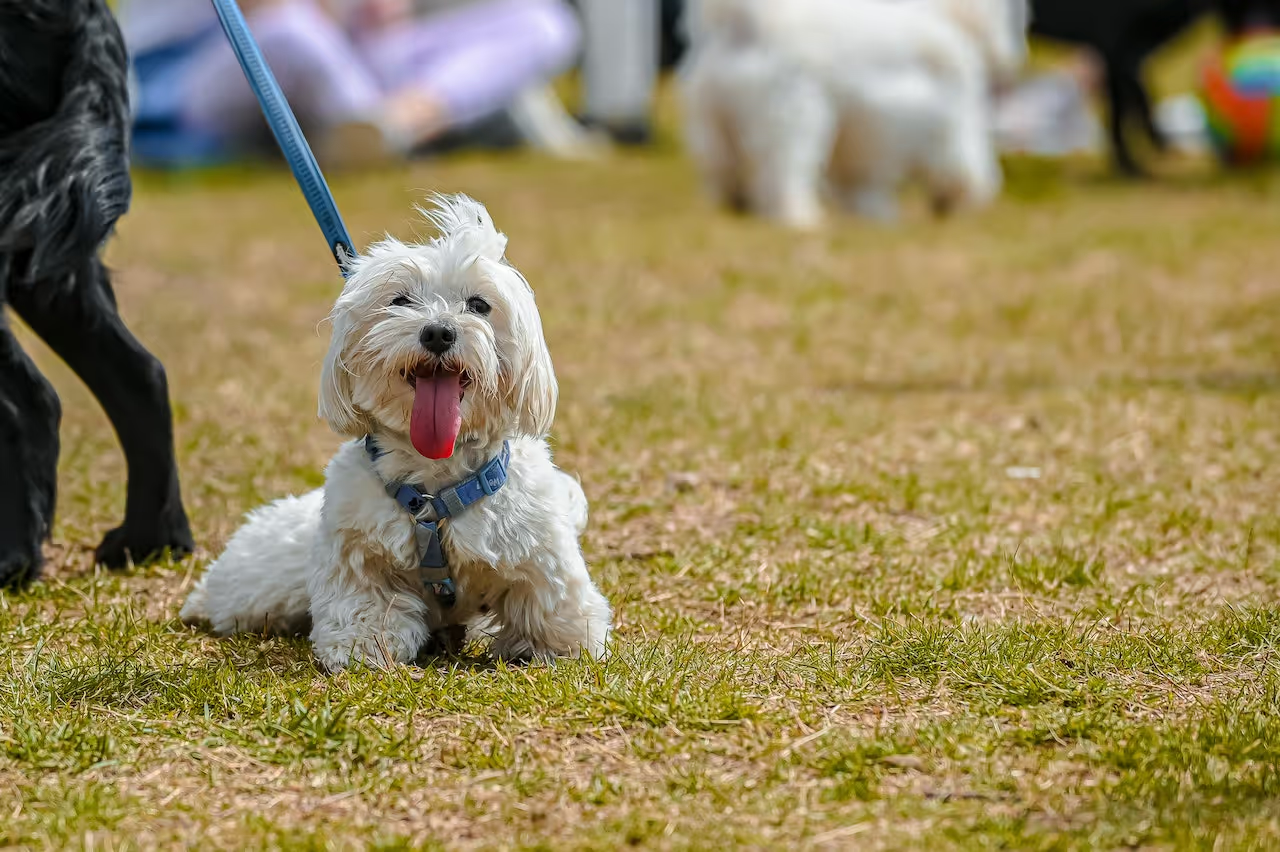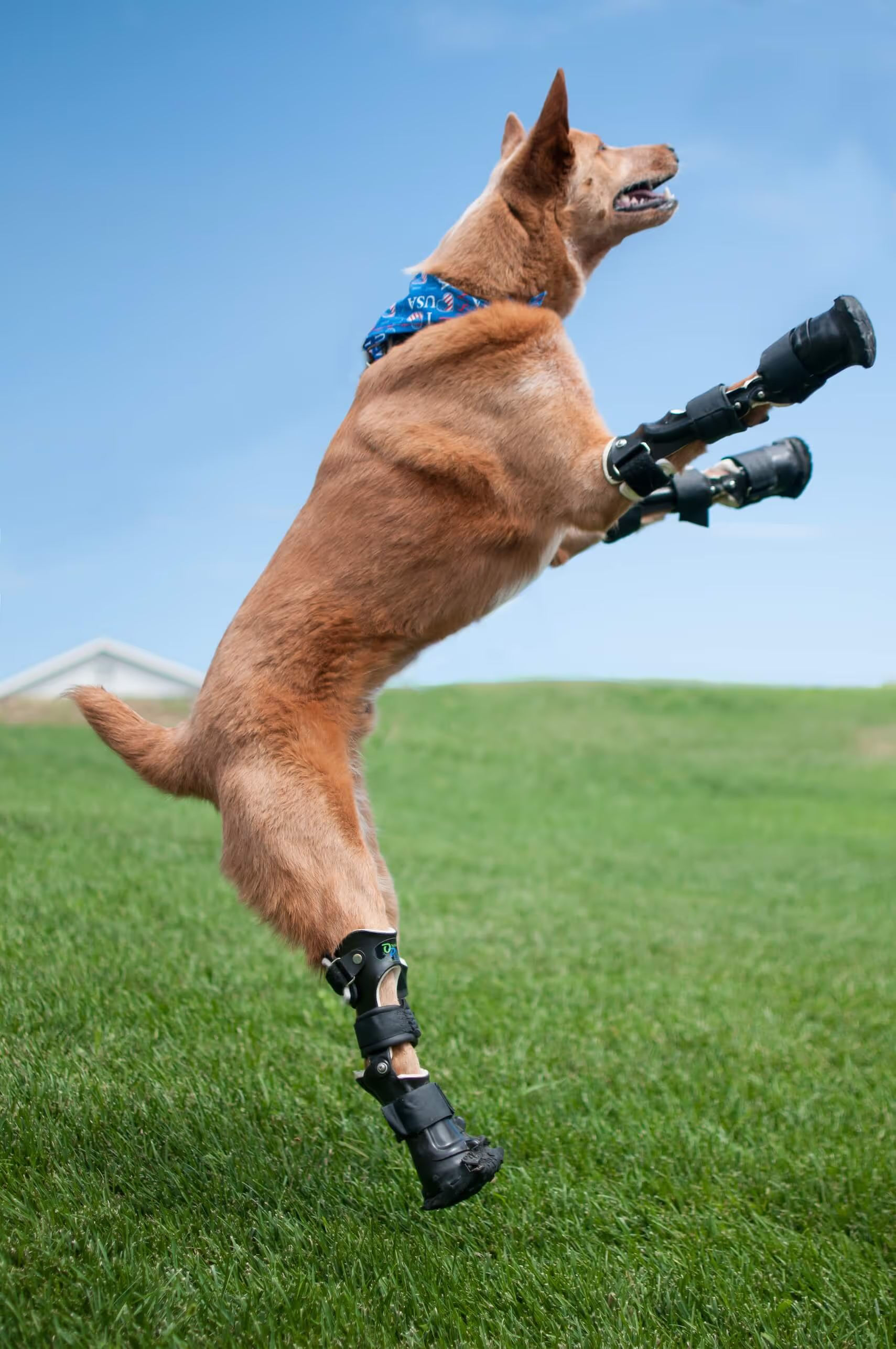Dog Leg Braces: When and How to Use a Brace to Get Your Pet Moving Again

Our four-legged housemates are our companions, training partners, and often best friends. Walking, hiking, jogging, and running with our dogs stimulate them mentally and physically and increase our bond. So, when our pups begin to falter in their daily behaviors, we naturally want to do whatever possible to extend their active life.
Fortunately, there have been several developments in orthotic and prosthetic treatment options for pets. In particular, braces and wraps are increasingly popular for keeping dogs active longer, whether a knee brace for small dogs or a leg brace for larger hounds, many support options are available for dogs of all shapes and sizes.
What are Dog Leg Braces?
If you’ve ever played or watched pro sports, you’ve likely witnessed a player wearing or adjusting a knee, elbow, ankle or another type of brace. These various braces can offer additional support and comfort for body parts.
Dog leg braces perform the same service. A leg brace helps a dog to move with less pain or discomfort.
When is it Time to Use a Leg Brace?
Using a leg brace is usually a response to a change in a dog’s behavior or a result of a veterinary diagnosis. The problem is that dogs can not verbalize where the pain is or what is stressing them. Some conditions are caused by physical activity, but some may result from predispositions based on the breed or specific injuries.
Leg and knee injuries aren’t frequent for smaller breeds since their size and weight are more proportionate to each other. However, luxating patella (MPL or LPL) is more common in small breeds. Signs a dog may need a leg brace can consist of the following:
- Limping or an altered gait
- Noticeable pain or discomfort when moving/walking
- Pain to the touch in certain areas
- Loss of coordination or agility
- Dragging a foot
- Slow to get up from lying down
Of course, these symptoms can be signs of many conditions and should be followed up with a veterinarian. If they are specific to the legs, a brace may offer the support and pain management needed to keep a dog moving.
What are the Different Types of Dog Braces Available?
One of the most common areas to brace is the knee or stifle joint, which requires a high-quality custom product for the best results. The wrist/carpus and ankle/tarsus are common areas to use a brace to support." It’s even possible to design prosthetic limbs for dogs.
- Stifle (knee) brace - Focuses on increased stabilization of rear legs, knees, and kneecaps, reduces the risk of injury to ACL, CCL, and other ligaments, and can be used in place of surgery for some patients. Knee braces are some of the most popular types of braces for dogs.
- Tarsus (rear foot) brace - Helps protect Achilles tendon, tarsal, and metatarsal areas post-injury.
- Carpus (front leg) brace - Effective in stabilizing and fixing bones, ligaments, and joints to promote healing and long-term mobility.
- Elbow brace - Works to reduce the effects of osteoarthritis or dynamic elbow luxation.
- Spinal or cervical brace - Helps support/reduce spinal sagging and assists in surgical recovery.
How Many Hours a Day Should a Leg Brace be Worn?
Consult your veterinary professional when considering how long a dog should wear a brace. Some dogs may only require a few hours during physical activity, whereas others may need to keep the brace almost indefinitely.
If they’ve experienced a severe injury or surgery, they may be required to wear a brace throughout recovery and, as needed, post-recovery. Consult the dog’s veterinarian and judge the dog’s brace requirements based on its physical responses and cues.
Tears or Ruptures of the Anterior Cruciate Ligament (ACL)
This ligament is one of the structures responsible for managing the movement and stability of the knees. Damage to these ligaments is common and treatable, often with a brace. Active dogs or heavy-set dogs are often prone to ACL injuries.
Slipping and Sliding of Knee Cap
Some small dog breeds, like Chihuahuas, Bichon Frise, Maltese, or Poodles, can be prone to a condition called the luxating patella or a knee cap slipping. The condition can be mild for some dogs, whereas others may experience severe discomfort. A brace can reduce the instances of this condition.
Arthritis and Discomfort in Joints
More significantly, heavier dogs like Great Danes, Mastiffs, Bulldogs, and Rottweilers can all fall prone to issues with knees and hips because of their size and weight. They can suffer arthritic conditions more often because of this. It’s also safe to assume that arthritic conditions can arise in almost any older dog, regardless of breed.
What to Consider When Choosing a Dog Leg Brace?
Buying a dog leg brace is much like purchasing a knee or ankle brace for yourself. Or a good quality pair of running or hiking shoes. A good brace is:
- A snug and comfortable fit
- Supportive of the problem area
- Easily adjustable
- Quick to put on or take off
- Made of durable, high-quality materials
What are the Top Benefits of Dog Leg Braces?
Using a leg brace can benefit a pet’s health in several ways. Take Sydney, for example. An eight 1/2-year-old Australian Cattle Dog. Sydney suffered bilateral Achilles tendon ruptures, which can be devastating for dogs.
Sydney recovered with custom-fitting articulating tarsal devices for use before and after surgery, but with some ups and downs. Read more to see how OrthoPets worked with Sydney’s vet and owners to offer the best possible devices for her condition.
Whether recovering from an injury or surgery or looking to avoid injury or pain, using a leg brace often helps pets, and their people enjoy a better quality of life for a longer time.
Allows Natural Healing and Scar Tissue to Develop Fully
Recovery from leg surgery or injury will be improved with the use of a brace.
It Comforts Your Dog and AIds in the Healing Process
It may be possible to avoid surgery for dogs, not surgical candidates, if a brace is used before a condition becomes too severe.
How to Choose the Perfect Leg Brace for Your Dogs?
Choosing the ideal leg brace can be a daunting task, as there are several support options. Consult your veterinarian to discuss if a custom orthosis or prosthesis would benefit your dog. In addition, OrthoPets offers a group of experts in veterinary orthopaedic surgery, veterinary sports medicine, veterinary rehabilitation, mechanical engineering, and human orthotics and prosthetics to aid in the decision.
Why is it Important to Buy from a Reputable Manufacturer?
Although a one-size-fits-all approach can sometimes work, it's more likely that a custom-fitted brace from a reputable company will offer a longer-lasting superior product.
Quality materials - Using tried and tested materials allows for more outstanding durability and performance from the brace.
Scientifically Backed - OrthoPets uses the newest veterinary technology to design products that work seamlessly with the patient.
Custom Design - Each brace is created from a mold of the actual dog. 3-D digital sculpting technology allows precise fitting for comfort and function.
Expert Assistance - Experts at OrthoPets assist with order precision, setting expectations and offering instructional assistance.
How Much do Dog Leg Braces Cost?
Leg braces will range in cost, depending on the size of the dog, the brace location, and the materials. Leg braces can be as inexpensive as $75 and range upwards towards $2,000 for specialized devices such as replacement limbs.
Ensure that Your Pet Stays in Optimal Health with OrthoPets!
Choosing to help keep your pets in top physical condition is part of our life contract with our furry friends. Going the extra mile to help them heal or proactively avoid injuries, aches, and pains sometimes means adding medical technology to your pet’s accessories.
Whether needing a knee brace for small dogs, or a full leg brace for surgical recovery, OrthoPets can guide you in the right direction. Our friendly and knowledgeable staff are here to help and get your pooch fitted for the perfect brace. Contact us today, and get the whole family moving again.


